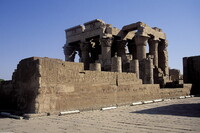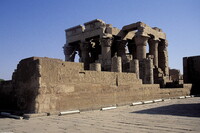| dc.coverage.spatial | Site: Kawm Umbu, Upper Egypt, Egypt | en_US |
| dc.coverage.temporal | ca. 180 BCE-117 CE (creation) | en_US |
| dc.creator | unknown (Egyptian (ancient)) | en_US |
| dc.date | -180-100 | en_US |
| dc.date.accessioned | 2013-04-17T18:25:29Z | |
| dc.date.available | 2013-04-17T18:25:29Z | |
| dc.date.issued | -180-100 | en_US |
| dc.identifier | 209116 | en_US |
| dc.identifier.other | archrefid: 987 | en_US |
| dc.identifier.uri | http://hdl.handle.net/1721.3/117102 | |
| dc.description | Remains of the Hypostyle Hall of Ptolemy XII; Kom Ombo is a site on a promontory of the west bank of the Nile, between Aswan and Edfu. Very little remains of the ancient Egyptian city of Ombos, which in Ptolemaic times (ca. 332-30 BCE) was capital of the 1st nome of Upper Egypt. However, the temple complex, dedicated to the crocodile-god Sebek [Sobek] and the hawk-god Haroeris (an aspect of Horus), is well preserved. The main temple was first constructed in the reign of Ptolemy VI Philometor (reigned 180-145 BCE), but its decoration continued throughout the Ptolemaic era (particularly in the reign of Ptolemy XII Auletes; ca. 80-51 BCE) and the period of Roman rule (Augustus, Tiberius, Domitian and Trajan; ca. 30 BCE-117 CE). Source: Grove Art Online; http://www.groveart.com/ (accessed 1/18/2008) | en_US |
| dc.format.medium | stone; painted relief; limestone | en_US |
| dc.rights | © Scott Gilchrist, Archivision, Inc. | en_US |
| dc.subject | architectural exteriors | en_US |
| dc.subject | rulers and leaders | en_US |
| dc.subject | Egypt--Religion | en_US |
| dc.subject | Roman Empire | en_US |
| dc.subject | Ptolemaic | en_US |
| dc.subject | Imperial (Roman) | en_US |
| dc.title | Temple Complex at Kom Ombo | en_US |
| dc.type | image | en_US |
| dc.rights.access | Licensed for educational and research use by the MIT community only | en_US |
| dc.identifier.vendorcode | 1A3-EG-KO-TC-B2 | en_US |
| vra.culturalContext | Egyptian (ancient) | en_US |
| vra.technique | carving (processes) construction (assembling) | en_US |
| vra.worktype | excavation (site) | en_US |
| vra.worktype | temple | en_US |
| vra.worktype | chapel (room or structure) | en_US |
| dc.contributor.display | unknown (Egyptian (ancient)) | en_US |


